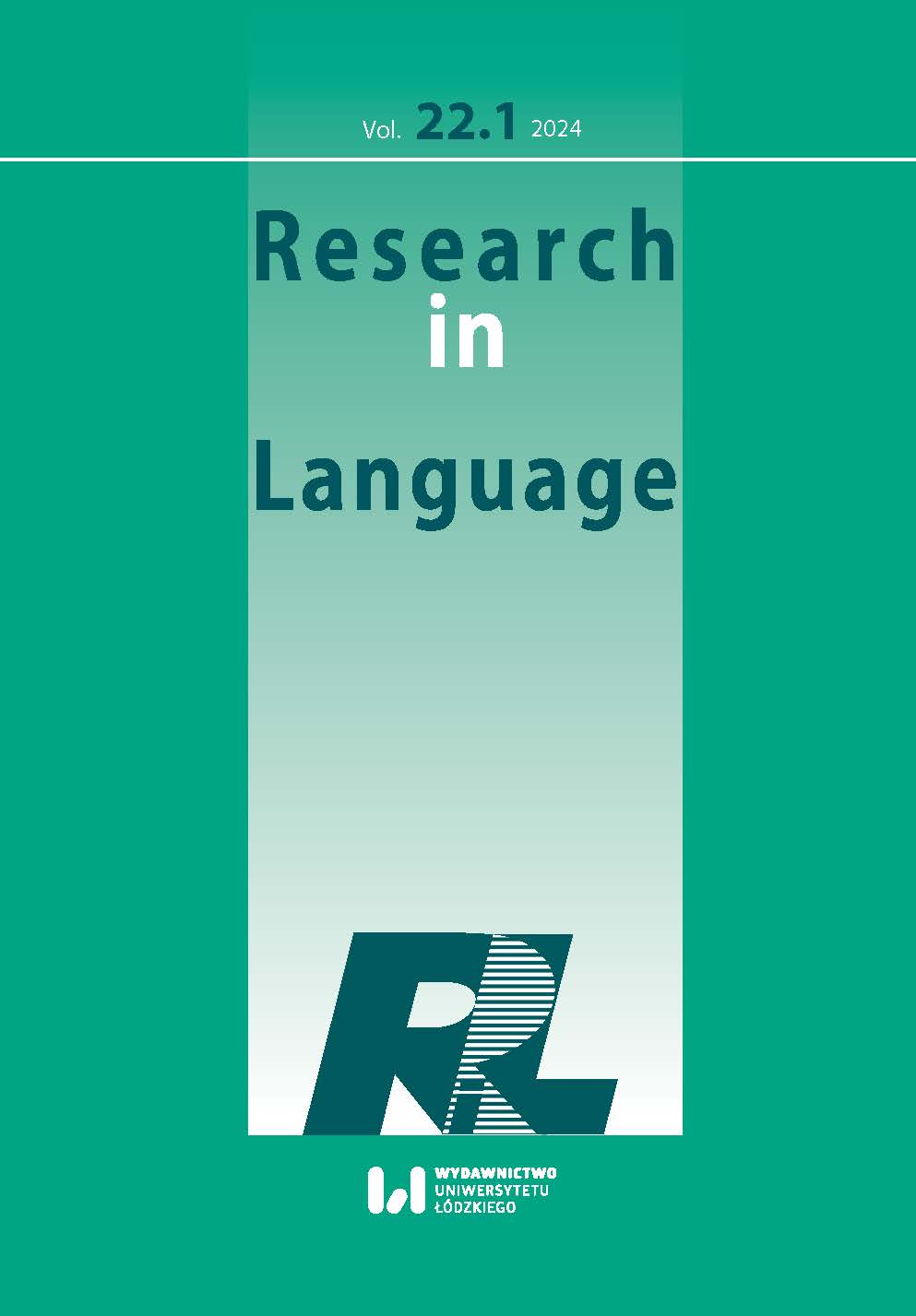Exploring the Status of Voiceless Labiovelar Fricative /ʍ/ in Contemporary American English
DOI:
https://doi.org/10.18778/1731-7533.22.1.02Keywords:
voiceless labiovelar fricative, social variables, age, formality, regionality, American English, prestigeAbstract
The study attempts to investigate the current status of the voiceless labiovelar fricative /ʍ/ in American English with reference to selected sociolinguistic variables, such as age, regional background, formality of the speech and prestige. The study comprises 17 subjects and 34 recordings of their speech – two recordings of a different level of formality per each speaker. All of the analyzed recordings are available online. The analysis focuses on wh-words, such as e.g. why, while, whale or white. In the first part of the study, the number of wh-context words in each speech is juxtaposed with the actual production of the researched variable. The second part of the study concentrates on the comparison of the obtained qualitative data with selected social variables. The results of the study may not only broaden the understanding of the voiceless labiovelar fricative use in American English but may also have pedagogical implications to whether the variable should be included in the phonetic courses on American English.
References
Chambers, Jack & Trudgill, Peter. 2004. Dialectology (2nd ed.). Cambridge UP
Google Scholar
Cruttenden, Alan (rev.). 1994. Gimson’s pronunciation of English. Edward Arnold.
Google Scholar
Eckert, Penelope. 1998. Age as sociolinguistic variable. In F. Coulmas (ed.), The handbook of sociolinguistics, 151-167. Blackwell. https://doi.org/10.1002/9781405166256.ch9
Google Scholar
DOI: https://doi.org/10.1002/9781405166256.ch9
Gordon, Matthew J. 2008. New York, Philadelphia, and other northern cities: phonology. In E.W. Schneider (ed.), Varieties of English 2: The Americas and the Caribbean, 67-86. Mouton de Gruyter. https://doi.org/10.1515/9783110208405.1.67
Google Scholar
DOI: https://doi.org/10.1515/9783110208405.1.67
Gordon, Matthew J. 2008. The West and Midwest: phonology. In E.W. Schneider (ed.), Varieties of English 2: The Americas and the Caribbean, 129-143. Mouton de Gruyter. https://doi.org/10.1515/9783110208405.1.129
Google Scholar
DOI: https://doi.org/10.1515/9783110208405.1.129
Hudson, Richard A. 2007. Sociolinguistics (2nd ed.). Cambridge University Press.
Google Scholar
Krapp, George P. 1927. Is American English archaic? Southwest Review,12 (4), 292-303
Google Scholar
Llamas, Carmen. 2007. Age. In C. Llamas, L. Mullany, & P. Stockwell (eds.)., The Routledge companion to sociolinguistics, 69-76. Routledge. https://doi.org/10.4324/9780203441497
Google Scholar
DOI: https://doi.org/10.4324/9780203441497
Longmore, Paul K. 2007. “Good English without Idiom or Tone”: The Colonial Origins of American Speech. The Journal of Interdisciplinary History,37(4), 513-542. https://doi.org/10.1162/jinh.2007.37.4.513
Google Scholar
DOI: https://doi.org/10.1162/jinh.2007.37.4.513
McDavid, Raven I. 1980. Varieties of American English. Stanford University Press.
Google Scholar
Minkova, Donka. 2004. Philology, linguistics, and the history of hw-w. In A. Curzan & K. Emmons (eds.), Studies in the history of English language II: Unfolding Conversations, 7-46. Mouton de Gruyter. https://doi.org/10.1515/9783110897661.7
Google Scholar
DOI: https://doi.org/10.1515/9783110897661.7
Minkova, Donka. 2014. A historical phonology of English. Edinburgh University Press. https://doi.org/10.1515/9780748634699
Google Scholar
DOI: https://doi.org/10.1515/9780748634699
Nagy, Naomi & Roberts, Julie. 2008. New England: phonology. In E.W. Schneider (ed.), Varieties of English 2: The Americas and the Caribbean, 52-66. Mouton de Gruyter. https://doi.org/10.1515/9783110208405.1.52
Google Scholar
DOI: https://doi.org/10.1515/9783110208405.1.52
Romaine, Suzanne. 2000. Language in society: An introduction to sociolinguistics (2nd ed.). Oxford University Press. https://doi.org/10.1093/oso/9780198731924.001.0001
Google Scholar
DOI: https://doi.org/10.1093/oso/9780198731924.001.0001
Thomas, Erik R. 2008. Rural southern white accents. In E.W. Schneider (ed.), Varieties of English 2: The Americas and the Caribbean, 87-114.Mouton de Gruyter. https://doi.org/10.1515/9783110208405.1.87
Google Scholar
DOI: https://doi.org/10.1515/9783110208405.1.87
Trudgill, Peter. 1975. Accent, dialect and the school. P. Doughty & G. Thornton (eds.). Edward Arnold Ltd.
Google Scholar
Wells, John C. 1982. Accents of English 1: An introduction. Cambridge University Press. https://doi.org/10.1017/CBO9780511611759
Google Scholar
DOI: https://doi.org/10.1017/CBO9780511611759
Downloads
Published
How to Cite
Issue
Section
License

This work is licensed under a Creative Commons Attribution-NonCommercial-NoDerivatives 4.0 International License.










